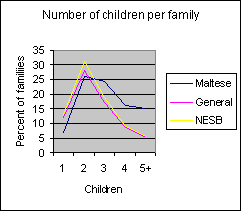3.8 Family SizeThere were 29.6 thousand households with a Maltese-born head in Australia in 1982 (Families Survey, 1982, see Castles, 1989). The average size of Maltese household (3.8) was higher than the Australian (2.8) or European (3.0) average, and very close to the Lebanese (4.5), and Vietnamese (4.1) levels and equal to Greek family size (3.8). The average number of dependent children per family was 2.3 (average Australian: 2.1, European: 2.0), which is the highest for all European groups and second to Lebanese (2.9) and Western Asian countries 2.4). 
Fig 3.7: Number of children per family. Maltese migrants tend to have more brothers and sisters than the average Australian or NESB persons. (Source.-OMA Families Survey, 1989,) These data suggest that the fertility rate has not materially changed over the years. The curious parallel with Lebanese and Turkish family size persists. Whether the high fertility rate indicates a biological cause which has been the pattern in Malta for several thousand years (cf the 'fat-lady' fertility symbols from ancient Phoenician times), or, as is more likely, it reflects a tendency to ignore birth control measures, remains to be established. Source: Maurice N. Cauchi - Maltese Migrants in Australia, Malta 1990
    
| 

![]() .
.